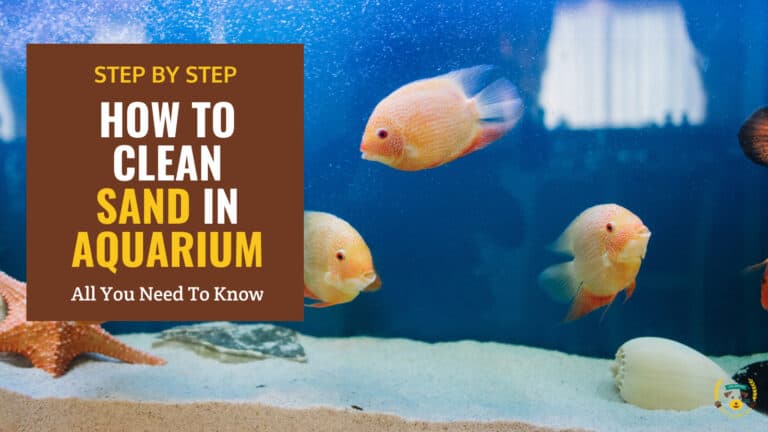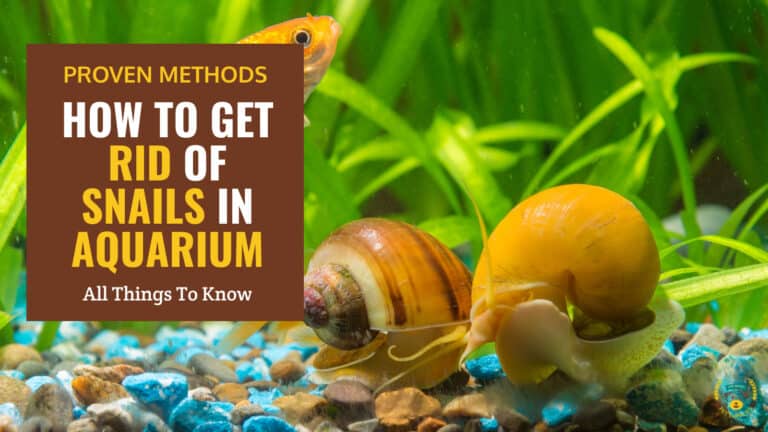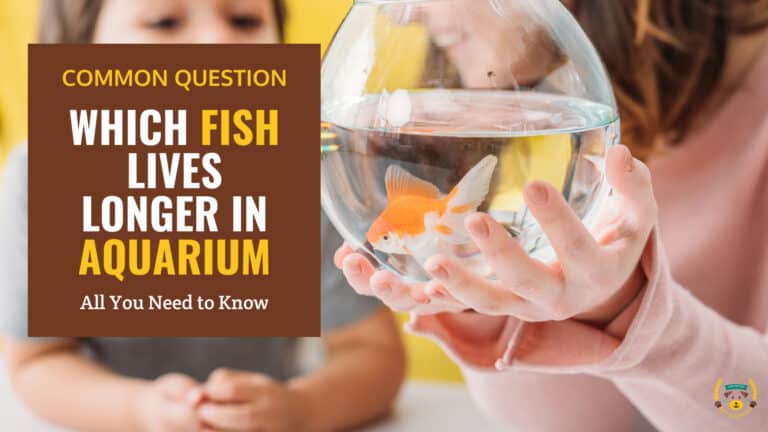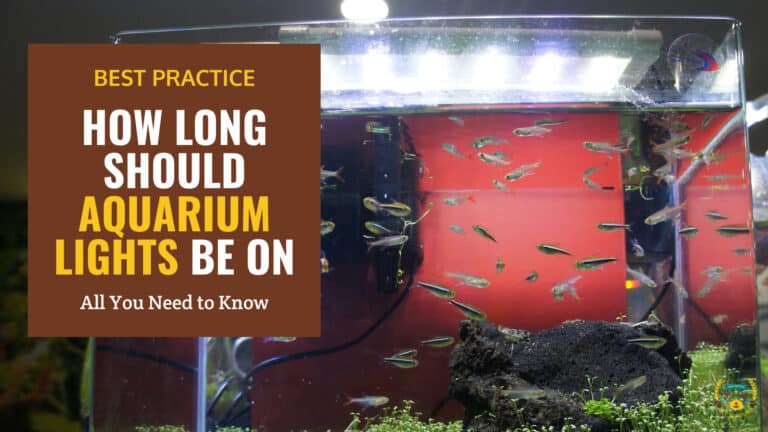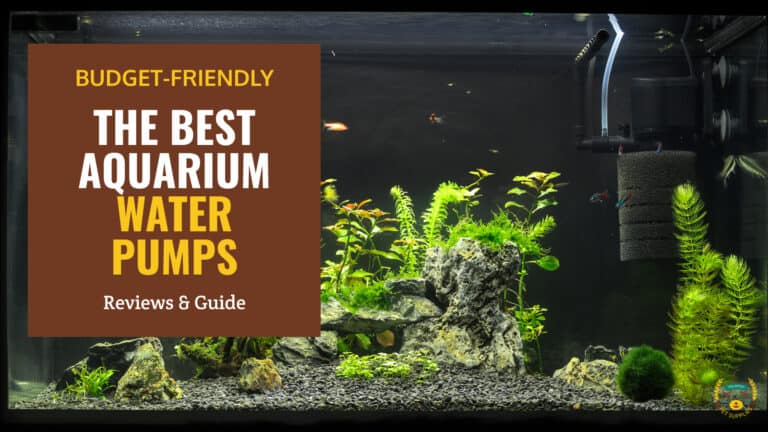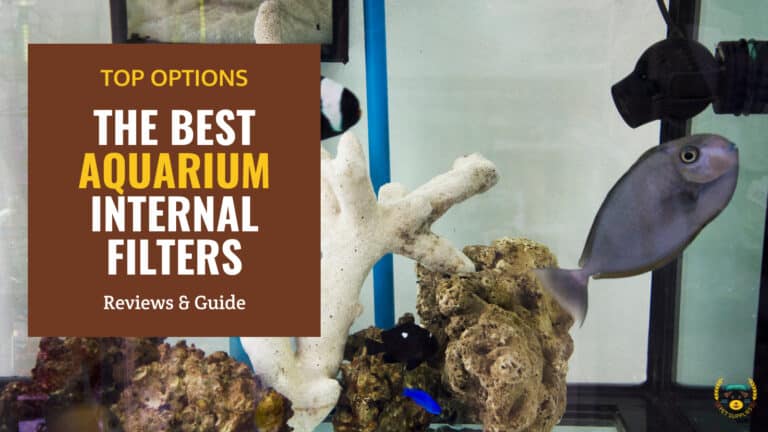What is The Best Canister Filter For Your Aquarium? 10 Best Picks Reviewed
Last updated: January 21, 2024
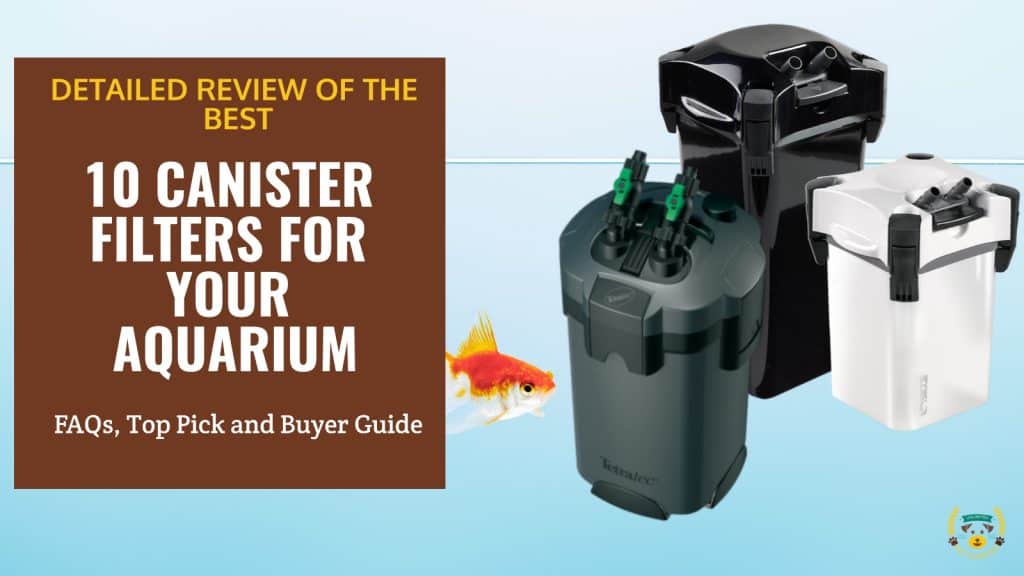
Summary
The Fluval 07 Series Performance Canister Filter is our top pick for the best canister filter for aquariums. It is a well-made, highly efficient, and easy-to-use filter that offers excellent value for money. The 07 Series has been improved in every way from the previous generation, with a quieter motor, lower power consumption, and more ergonomic design. It also comes with a variety of additional media packs, making it easy to customize the filter to your specific needs.
Fish are some of the most difficult pets to keep because they are fragile creatures; any dysfunction or change in water quality or temperature could be a disaster for your beloved pets. Even the easiest fish to keep can not tolerate bad water quality. Therefore, an excellent filtration system is a prerequisite for providing a clean environment for your aquatic buddies. It also helps to prevent the tank from getting dirty.
In addition, these filters are also required for maintaining the level of dissolved oxygen [1] in the water. Therefore, investing in a high-quality canister filter is crucial to the health and well-being of your fish pets.
These filters have grown in popularity, and many people are choosing canister filters for their aquariums over any of the other types of filters. As a result, the market is usually inundated with options. With so many different brands and products, it may become challenging to select the best canister filter, especially if you are an aquarium fish beginner hobbyist.
The number of choices that you have can be overwhelming, and making your mind up can be a real challenge, But do not fret as we have got you covered! We are here to take you on a tour around different best-quality filter manufacturers to help you with the task of choosing the most suitable filter for you and your pets' needs.
We have reviewed the ten top-rated canister filters to help you narrow down your choices. We have included all the major products in our review and hope that you will be able to choose the best aquarium canister filter for your pets after reading this. The products we are reviewing here are the best of the best, and we tried to give a fair comparison so that you can choose the right one based on your personal preferences and/or the needs of the specific fish you are intending to keep.
No Time To Read The Whole Article? No Worries. We’ve Done The Work For You And Compiled A List Of The Top Performers.
| Product | Features | Our Rating |
|---|
How Does A Canister Filter Work?
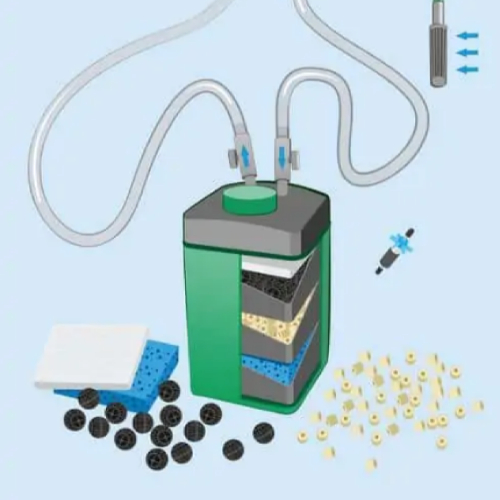
Much like a car, a fish tank needs regular maintenance to keep it running smoothly. Without it, the tank can quickly degrade—especially once fish and other animals are added to the mix.
Aquarium canister filters are a great way to filter a fish tank. They are specifically designed to run continuously for long periods of time on a specific schedule. The fish canister filter uses a series of canister filters, usually within a single housing (though sometimes, each filter is in a different housing), and works by passing water through different parts to filter it.
First, the water is fed by the aquarium pump through a foam pad that absorbs chemicals; then the water goes into a sponge that absorbs organic matter, then into a mechanical filter media that does the actual filtering. There are two types of canister filters: internal filters and external filters.
What Are The Benefits Of Using A Canister Filter?
Canister filters provide many benefits over other types of filters; that's why many people choose them for their aquariums. Let's go through some of those advantages individually.
Easy Setup Process and Cleaner Setup
Installing a canister filter is a very easy process. It is installed next to the aquarium, plugged into an electrical source, and immediately starts doing the job. The whole system is a loop: one hose sucks the dirty water into the different sections of the filter and the other one pumps the freshly filtered clean water back into the aquarium.
Cleaning is easy too; you just open the filter, take out the different filtering compartments and media and clean them with water (or replace them). The body of the filter may also be scrubbed with a toothbrush.
Flexible Filter Media Selection
Canister filters come with multiple compartments, each containing different filtering media such as foam, sponge, gravel, carbon, wool, etc. Each type of media can filter specific items: organic, chemical, or mechanical filtration.
The order through which the water is filtered inside the filter is flexible and can be controlled by the owner. In other words, the owner chooses the order and the type of media to use based on personal preference or the kind of fish living in the aquarium for optimal filtering results. Different media configurations can be tested to see which one works best.
High Water Flow Rate
This is one very important advantage that canister filters provide: A higher flow rate. This simply means how much water runs through the filter and goes back to the aquarium in the period of one hour. Usually, the flow rate of any given filter is calculated using the acronym GPH (gallons per hour) [2], and every filter provides information about its technical details, including the GPH.
The higher the GPH, the more water is filtered, the cleaner the water, the healthier the fish. However, the GPH must not be exaggerated, as it can create strong currents in the aquarium, which is not ideal for some types of fish, such as the Betta fish. Ideally, the GPH of a filter needs to be at least five times the capacity of the tank.
Long-Lasting
Don't worry about replacing your canister filter as those can last for years. Many fish owners talk about filters they have had for up to 15 years or even more without the need to replace them. Most of the time regular cleaning will do the trick.
Sometimes, owners have to replace some media to solve clogging issues or just for the desire to always try the latest and greatest in filtering media. Rest assured, you will have to regularly clean your filter; you may need to replace the media, but the filter will stay with you for a very long time unless you choose otherwise.
Quiet Operation
There is no completely quiet aquarium filter; they all make some noise, be it to different degrees. However, no one can deny that canister filters are much quieter than any other type of filter. This is because canister filters are designed to operate for very long periods of time; they are usually made of high-quality materials. The quality of the pump is better too, which translates into quieter operation. The fact that all the filter components are enclosed inside also helps make canister filters a quieter option.
Here is a great video (7 minutes 44 seconds) from Prime Time Aquatics discussing the pros and cons of aquarium canister filters.
Top 10 Best Aquarium Canister Filters Reviews
Before we get started, note that as different canister filters have various features and capabilities, you must do some groundwork before buying one. Keeping that in mind lets us know more details about the best canister filters available for your fish tank.
Based on our research, testing, and experience, below is our final list:
Fluval 07 Series Performance Canister Filter for Aquariums
Fluval has become one of the most well-known and trusted brands of canister filters and aquarium necessities makers among aquarium enthusiasts. The 07 series canisters come in four different versions with a GPH between 145 and 383 to cover as many tank settings as possible. Power consumption ranges between 10 and 23 watts depending on the model, making them some of the most power-efficient canister filters available on the market.
The motors in the 07 series pumps have been completely redesigned to make them more power-efficient and much quieter. As a result, they are up to 25% quieter than the previous generation. The design of the filters has been improved too, as they come with rubber feet to avoid vibrations; the Aqua Stop valves are easy to remove without leakage with the push of a small valve.
The motor head can be easily attached or removed with its single-action dual locking clamps. A center handle allows for easy access to the whole media basket, and a redesigned stronger handle helps with effortless priming and startup. The cherry on top is that the 07 series offer a 4-stage media filtration and come with the necessary accessories the buyer may think of, in addition to authentic replacement Fluval media that will get your filtration needs covered for a while.
Pros
- Excellent Value for money. Not cheap but the quality and performance justify it.
- Everything has been improved: Efficiency, power consumption, maintenance, etc.
- Very well made.
- Included additional media packs for happier customers.
- Easy to diagnose.
Cons
- No UV light sterilizer included; to be purchased separately.
Fluval is a brand that has been around for decades now, and they have shown great improvements with each generation of their canister filters. The 07 series are no exception, as they have been improved from every possible angle.
Compared to the previous generation, the 07 series are quieter, more robust, ergonomically designed, more power-efficient, and easier to operate and maintain. An excellent brand that has always made great products and somehow always found ways to improve them. Highly recommended.
Fluval FX High Performance External Canister Filter
Fluval is a top-rated canister filter manufacturer. Their fish tank canister filter is available worldwide and has won the trust of several users. This particular model of canister filter scores high on build quality and reliability and is a great display of the company's expertise and technological advancement. Moreover, they are available in two sizes so that you can choose an aquarium canister filter as per your requirements.
Both versions provide staggering features and performance and are intended for use with very large aquariums. The FX 4 is meant for aquariums of up to 250 gallons of water and has a DPH of 700. Its bigger sibling, the FX6 works with aquariums of up to 400-gallon capacity and features a whopping 925 gallons per hour, making the two some of the most powerful canister filters money can buy today.
In order to improve the performance of their fish tank canister filter, all the models feature better impellers and motors. As a result, the head pressure and flow rate have also increased. However, this has not made it nosier. The re-engineering has also increased the durability of the FX series canister filter.
The patented Aqua-Stop valves have made maintaining the filter easier. As a result, it is not only less troublesome to disconnect the hoses, but it also makes them less likely to leak.
The filtration pathway's thoughtful design makes sure that the water remains inside the filter for as long as possible. The water quality is brilliant as it travels through multiple media filter buckets before heading back into the tank.
The smart pump technology uses a patented microchip that monitors and optimizes the pump performance and ensures self-priming, quiet operation, and power efficiency. With the utility valve and hose on the FX canisters, water-changing and system drainage have never been easier. Intake and output have also been greatly improved, with a telescopic stem and anti-clog strainer in addition to the twin, multi-directional water nozzles that help customize water currents.
The only limiting factor of The Fluval FX series filter is the high price. However, this is reasonably expected as the product has many useful features that truly justify its cost. It is strong, dependable, and suited for both saltwater and freshwater aquariums.
Pros
- Amazing filtration rates.
- Exceptional build quality.
- Filter media is included in the package.
- Efficient, quiet, strong, reliable.
- Available in two different sizes with excellent performance.
- No problems handling high-capacity tanks.
- Decades-long expertise displayed through the FX series.
Cons
- The high price may be a deterrent.
With its FX series canister filters, Fluval has shown its domination over the high-end, high-performance filter market. They excel in all aspects of their performance.
The price, however, is a little too high for the average customer and will prevent many from acquiring this excellent filter. It can be easily justified, though, if we look at the outstanding quality and performance of the FX series canisters.
Polar Aurora External Aquarium Canister Filter
If you are looking for a cheap fish tank canister filter with some very useful features, it's worth looking at the Polar Aurora external aquarium filter.
This canister filter also features a built-in UV sterilizer. Its 9-watt UV Sterilizer reduces the growth of algae and bacteria. The impeller and motor work together to push around 370 gallons of water every hour. This model is suitable for an aquarium of up to 100-gallon capacity. If you have a fish tank with a higher capacity, opt for the larger-sized filter.
This model makes use of 3 media trays to keep the water clean. Users have the option of adding the media according to their preferences. This canister filter also has a spray bar that you can use to adjust the output flow. It features an O ring at the opening that helps to keep the filter sealed and prevent leaks. As the 35-watt pump is self-priming, there is no need for manual siphoning.
Pros
- It is inexpensive
- Has a good flow rate
- The installation and maintenance is easy because of the swivel hose joints
- Good customer reviews
- Has an in-built UV sterilizer
Cons
- Only suitable for fishes and no other aquatic creatures like turtles.
The Polar Aurora external aquarium filter gets the job done conveniently. The self-priming feature and UV sterilizer are a big plus, considering the low price at which it is available.
Aqueon QuietFlow Canister Filter
The Aqueon Quietflow works for both freshwater and saltwater aquariums and comes in three variants to cover different customer needs and tank capacities. The smaller version with a 200 GPH works for aquariums with a capacity of up to 55 gallons. The medium version of 300 GPH suits tanks between 55 and 100 gallons, while the bigger filter has a GPH of 400 and is better suited for tanks with a capacity between 100 and 150 gallons.
The prices of the units range between $115 and as high as $450. The three variants come with an innovative water-polishing unit that hangs to one side of the aquarium and greatly simplifies maintenance: the owner just needs to replace the internal carbon cartridge. That's a big time-saver on maintenance.
The QuietFlow is also a versatile filter. It offers many possible water return options: Spray bar, water polishing unit, and water director. Of course, it's up to the owner to choose their preferred water return option. The filter includes the three necessary filtration compartments: Biological, chemical, and mechanical, with the possibility to choose different configurations.
The hoses, valves, pump locking heads, water intake/output connections, and the polishing unit are all quick disconnect, which translates into much shorter maintenance sessions.
Pros
- Different versions = more satisfied customers.
- Less maintenance: replacing the cartridge takes a few seconds.
- Quick connect/disconnect is a time-saver.
- Versatility: numerous possible configurations.
- Easy to clean and maintain.
- Quiet operation.
Cons
- A little bit pricey.
This is an overall excellent filter that comes with everything you need to make your fishies happy and comfortable. It also gives you a lot of choices with different options and configurations. If you can afford it, this is the filter to get for your fish tank, whatever the capacity.
Penn Plax Aquarium Cascade Canister Filter
For over 60 years, Penn-Plax has been producing high-quality pet supplies. Since its humble origins as a pet store in Brooklyn, the company has come a long way and has now become a well-known global supplier of heavy-duty pet equipment. Their range of aquarium products is particularly noteworthy. Therefore, it is hardly surprising that the Penn-Plax Aquarium Cascade occupies a high position in our aquarium canister filters review.
This model features a multi-stage filter that ensures a sparkling clean environment for your beloved pet. Moreover, it works in both freshwater and saltwater aquariums. The Penn-Plax Aquarium Cascade is robust and can efficiently clean tanks with a capacity of 100-gallons. As all the parts required to set it up come along with the product, you do not have to worry about spending additional money to install the filter.
The filter has swimming pool-style rotating valves. You can use them to control the flow and prevent any leaks. It also comes with a larger filter tray that will last for a long time. Additionally, changing the media is not difficult due to the easy-to-lift clamp that provides quick access to the filtration media and other parts that need maintenance.
Pros
- Affordable price.
- Easy to install and maintain.
- High-quality valves that rotate 360°.
- Supports any combination of media.
- Valves are designed with a shut-off control feature.
Cons
- The model consumes more power compared to others.
If you are looking for a canister filter that you can customize according to your needs, the Penn-Plax Aquarium Cascade is an excellent option to consider with its three large media baskets.
ZooMed Nano 30 External Canister Filter
The Zoomed Nano 30 external filter has almost everything you need to know in the name. It is intended for fresh and saltwater aquariums and nano-tanks with a capacity of up to 30 gallons. The GPH of the unit is 120. It is a light, small canister that takes very little space and does a great job thanks to its 3-stage filtration process. Moreover, it is easy to prime, open, and customize with its easy-to-open filter head, adjustable flow-control system, and removable hose-connecting device, making it easy to handle by new users.
Pros
- Small in size, big on performance.
- Works for animals other than fish (frogs, turtles, etc.)
- Quick installation, mounting, and disassembly.
- Very quiet, thanks to the anti-vibration system.
- Offers control of the flow rate.
- Competitively-priced.
Cons
- The GPH may be too low for some users.
The filter also contains anti-vibration bushings, meaning it will remain almost silent no matter how long it operates. Its adjustable flow-control system is an excellent addition since it provides the possibility to adapt the filter's performance to your needs or those of the tank inhabitants.
Marineland Magniflow Canister Filter for Aquariums
Next on the list is the canister filter from Marineland. It is an entry-level model that checks all the right boxes for a budget-friendly filter. This model has some useful features and maintaining it is not tedious.
It has a basic valve stop system. So, all you have to do is to disconnect the valves and lift the red lever. The water will immediately stop flowing and thus prevent any leakages. Apart from this, the entire unit can be easily sealed with the help of a simple push button.
Unlike the advanced canister filters, using this model's locks and levers is a child's play. This product comes with a quick prime button that does not make restarting the filter after cleaning a chore. This canister has very few moving parts. As a result, the chances of a breakdown are significantly less.
Pros
- Excellent customer service
- Efficient valve stop system that prevents leakage
- Quick priming button
- Multistage filtration
- Easy set-up
Cons
- The hose connections tend to loosen over time
In this fish tank canister filter, the water flows through 4 filtration stages. The 1st stage is the mechanical stage in which the water passes through pads and sponges. In the 2nd, which is the chemical filtration stage, the water passes through activated carbon. In the 3rd stage, which is the biological filtration stage, the water passes through bio balls. In the 4th stage, water passes through a water polishing pad before returning to the tank.
EHEIM Classic External Canister Filter
The German-engineered Eheim classic is durable and has a good throughput rate. It is also one of the quietest canister aquarium filters available in the market today.
The Eheim classic has a compact design and comes with easy-to-handle latches. This model has small stainless-steel clips to secure the motorhead tightly to the canister instead of plastic clamps. To set up the filter, you must carefully follow the instructions provided in the manual.
The classic series is not a new entrant. It has stood the test of time and continues to feature along with the best aquarium canister filters. It is, therefore, easy to find any replacement parts for this canister filter. Moreover, the Eheim classic is an energy-efficient fish tank canister filter with an impressive flow rate and is best-suited for goldfish tanks.
Pros
- Compact, efficient, and quiet operation
- Proven and durable design that is easy to operate
- Holds substantial filter media
- Media is part of the kit
- Silent operation
Cons
- No self-priming function
The Eheim classic is available for 90, 66, and 40- gallon tanks. The product comes with a spray bar, installation accessories, hose, and inlet pipe. It also comes with a 2-year warranty. The only disadvantage of this model is that the water does not flow through the filter automatically. Users must therefore follow the tips provided to prime the filter manually.
SunSun Pro Canister Filter Kit
Although the brand is a fairly new entrant in the market, its popularity is growing by the day and for all the good reasons. Just like the other top canister filters, this model is also durable and delivers high-quality performance. Moreover, it is a budget-friendly aquarium canister filter, and you will surely be impressed by its efficient work.
The SunSun Pro canister filter kit comes with one unit of blue coarse pads and three units of extra white filter pads. Along with these, 40 pieces of bio balls, 1 lb. of ceramic rings, and 1 lb. of premium filter carbon are also included in the kit.
One of this model's most standout features is that it has a 9-watt built-in UV sterilizer. This helps to kill bacteria and algae spores and keeps the water crystal clear. In addition, the blue self-priming pump eliminates the need for manual siphoning. With the three flexible media trays, the filter performs mechanical, chemical, and biological filtration efficiently.
Pros
- Value for money
- Kit includes a UV sterilizer
- Comes with a self-priming pump
- Easy to clean and maintain
- Noise-free operation
Cons
- The LED bulb of the UV sterilizer starts to lose power over time
Cleaning and maintaining this model is a breeze. You can detach the input and output hoses at one go by pressing a switch that will instantaneously cut the water off. The SunSun Pro canister filter has a powerful motor and works silently. This model is ideal for aquariums with a capacity of up to 75 gallons. It has a flow rate of about 265 gallons per hour.
Aquatop CF Series Canister Filter
The USP of the Aquatop CF series canister filter is that it has a UV filter that provides extra cleaning power and keeps the water in the aquarium cleaner. In addition, the UV filter sterilizes the water that has passed through the other filter stages before it goes back into the tank.
It is beneficial to install an aquarium canister filter equipped with a UV filter as the UV lights destroy microorganisms such as algae and bacteria present in the water. If you give it some additional time, this canister filter can even kill little beasties like protozoa.
The UV filter is not the only stand-out feature of this canister filter. It is well built, and there is no need to siphon the water into the filter as it comes with a self-priming feature. This canister filter is suitable for both fresh and saltwater aquariums and comes with all the plumbing necessary for installation.
Pros
- Has an in-built UV sterilizer
- Comes with a self-priming pump
- Has a good filtration design
- Quiet operation
- Delivers crystal clear aquarium water
Cons
- Pricier than other similar models
Before the water passes through the UV filter, it goes through 3 stages of filtration, namely mechanical, chemical, and biological. This filter is available in different sizes. The smallest filter is capable of moving 264 gallons/hour, and the largest filter can move 525 gallons/hour. If you have a tank with a capacity of 100 gallons, opt for the mid-sized model that can move 370 gallons/ hour.
Things To Consider When Choosing A Canister Filter
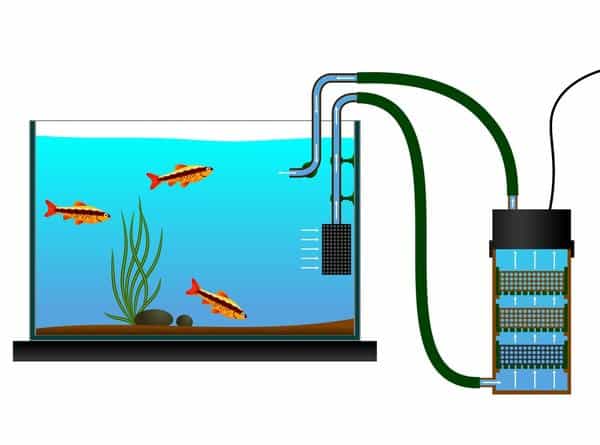
There are many important (technical) factors to consider when buying an aquarium filter, including efficient filtration, noise levels, and pump efficiency. But the most important thing you need to realize is that canister filters are not for everyone. They're a massive investment, and you'll need to devote some time to maintenance if you decide to buy one. You'll need to replace or clean the filter media regularly, but first and foremost, you need to think about the placement of the filter.
It would help if you considered how the aquarium canister filter would fit into or near your aquarium. Is it going to be internal or external? If you already have a filter, you should also look for canister filters that have at least the same flow rate as your existing filter (assuming that you don't want to use a canister filter all the time).
Now, let's cover the more technical stuff in detail.
Tank size
It is vital to know precisely the capacity of your aquarium and choose the filter accordingly. Canister filters are recommended for 40-gallon tanks or more. If you have a smaller tank, it would be better to opt for another type of filter or choose a smaller canister filter to use after some modification and tweaking.
In a nutshell, larger tanks need bigger and more powerful filters, while smaller aquariums will be just fine with smaller less powerful filters. There is a well-agreed-upon rule among fish lovers that states that the GPH of the filter should be about five times the capacity of the aquarium. If the filter is too powerful for the tank it could create too much water movement causing some disturbance and problems for the tank inhabitants.
Filter Flow Rate
The filter flow rate refers to how much water can go through the filter in one-hour GPH. The higher the GPH, the better the filtration process. However, a filter with a GPH that is too high will create too much current and movement inside the tank, and that's not ideal for most fish types. If the flow rate is too low, the filter may not be able to keep the tank clean. In fact, this factor is closely linked to the size of the aquarium. Owners could always go for the rule of the GPH being five times the tank capacity.
The Motor Noise
The motor or pump is the tool that constantly moves water between the tank and the filter. If the pump stops working, the whole filtration process comes to a halt. Therefore, you need to choose a filter with a good-quality pump that will last longer. A powerful pump provides excellent performance but may make more noise while operating, whereas a weaker one won't make as much noise at the expense of performance. Buyers need to strike a balance between comfort and performance.
Power Consumption
Bearing in mind that the filter will be working for extended periods of time, it is crucial to take power consumption into consideration. If the filter consumes a lot of power, that will show on your electricity bill at the end of each month. On the other hand, if power consumption is acceptable, but the filtering performance is not good, this can cause even more serious problems for your tank and fish. Ideally, you want to purchase a filter with reasonable consumption that doesn't neglect performance.
The Quality of the Manufacture and Materials
I believe this is the most important factor to consider for the sake of your beloved fish pets. The manufacturing quality and used materials should be the best possible you can afford. Good-quality materials mean the filter is safer for the fish and that the filtering process will be excellent.
Cheap materials may be harmful to your little fishies, as they may contain toxic elements that would spread in the tank and hurt or even kill the fish. The bottom line is, don't cheap out when buying your canister filter; just buy the best one you can afford.
Your Budget for the Aquarium
The budget may be last in our factors list, but it is the one that eventually has the most significant impact on your decision of which filter to purchase. You can't buy something you can't afford. So, the best thing to do is to precisely know your budget for the filter and make a list of filters you can afford. Then, finally, compare all the products on your list using all the other factors we discussed above and carefully make your final decision.
Frequently Asked Questions About Canister Filters
Canister Filter Vs Power Filter, Which One Is Better?
Canister filters and power filters are two of the most popular kinds of filters. The point of a power filter is to be a simple and straightforward piece of kit. As such, the operation is very simple and doesn’t need much setting up. The power filter hangs on the aquarium and draws water through a tube into the filter using a pump.
This water is then cleaned via a carbon filter and other chemicals that purify and remove harmful substances from the water. Depending on the model of filter you buy, you can get any combination of biological, chemical, or mechanical filtration.
However, canister filters offer superior performance when compared to power filters. They are capable of filtering large amounts of water quite quickly. They are also versatile and allow users to choose their own mechanical, chemical, and biological filtration mix.
With a canister filter, you do not have to worry about water splashing everywhere when it returns to the tank, as it usually comes with a spray bar that prevents this from happening. Although an aquarium canister filter costs more than a power filter, its performance justifies the cost.
What Is Biological, Chemical, And Mechanical Filtration?
Throughout this article, we have mentioned on more than one occasion filtration types, namely biological, chemical and biological filtration. They are the three key elements that make canister filters more efficient than any other type of aquarium filter thanks to their multi-stage filtration. What do they mean? How do they work? Why do they need different types of filter media? It's time to answer these questions.
Biological filtration stands for the use of biological agents to clean the aquarium water and get rid of any debris or toxins that prosper in the water. Beneficial bacteria are used to clean the water from any dissolved organic chemicals, which can be the sources of algae, bacteria, nitrate, and all types of harmful elements that grow in the aquarium. The beneficial bacteria feed on those elements and make them less toxic and harmful. Simply put, Biological filtration uses organisms to remove waste and debris from the water, and it is the primary method for keeping your aquarium water clean.
Chemical filtration is a process that removes chemical impurities from the water. These impurities can include minerals, medications, pollutants, and other substances that would make the water unhealthy for the fish.
Chemical filtration is one of the most important parts of an aquarium because if the water is unhealthy, the fish will be sick and may even die. Usually, activated carbon, or any other cleaning resins, is used to absorb impurities from the water by absorbing them. Chemical filtration relies on chemical agents to perform the cleaning and filtration process.
Mechanical filtration uses mechanics, in this case, the movement of water that is propelled by a water pump and goes through the mechanical filtration media to catch any impurities without doing anything to modify the chemical properties of the water. The simple water movement through the filtration media such as a sponge or foam is enough to physically stop solids from going through it.
Mechanical filtration catches unsightly particles like dust, fish excrement, uneaten food, etc. Mechanical media need regular cleaning and replacement because of the build-up of the impurities that can seriously affect its normal functioning.
Which Aquarium Filter Is Best For Me?
We can't really answer this question for you, as this matter is highly subjective. Every user can have a favorite filter based on their own personal preferences, experience, and other factors like the size of the tank, the type of fish or any other aquatic animal to be kept and their specific needs, The type of water to be used, the person's ability to tolerate noise and sacrifice some comfort for the sake of performance, etc.
That's a pretty long list of factors that come together to help the potential buyers make up their minds on which canister filter will be best for them. We are sorry, but it's time for you to take matters into your own hands. We reviewed the best canister filters and specified some important factors that can affect your choice; now, it's up to you to do some homework and decide which canister filter is best for you.
Here's an informative video (13 minutes 33 seconds) from Prime Time Aquatics about choosing the right filter for your fish tanks.
Can You Use A Canister Filter With A Sump?
The short answer is yes; it is technically possible to use an external canister filter with a sump tank. The more realistic answer is: It can be done, but it is risky. A sump is an additional water tank that can be placed underneath the display tank, next to it, or any other place where it won't be visible. Many people choose to do it for esthetic reasons: the view of the display tank is not disturbed by any hoses, pumps, heaters, etc., as everything can be placed in the hidden sump tank, making the aquarium better-looking.
The more practical reasons for doing so are numerous; for instance, the water will be cleaner and contain more oxygen, filtration will be even better, the visible surface gunk will be trapped in the sump, and the volume of water will be higher. Gravity helps move water from the aquarium into the sump, going through the filter, and an additional pump can be used to pump it back up towards the display tank.
This looks promising, useful, and practical, but if any setup components fail, this could mean disaster; if one of the pumps dies, one of the two tanks will overflow, while the other will be emptied. Water flow needs to be precisely calculated and regulated to keep both tanks full of water. In the end, it is a fantastic setup that requires a lot of work and attention, but if you're willing to make the effort the result is worth it.
Can You Run A Saltwater Tank With A Canister Filter?
Before buying a fish, it's crucial if it needs fresh or saltwater. That helps decide which filter to get. The answer to the question depends mainly on the manufacturer and the canister filter itself. There are a lot of filters today that can work with both freshwater and saltwater without any problems. However, you need to make sure the filter supports saltwater; otherwise, a protein skimmer may be required to help with saltwater filtration.
Usually, using a canister filter with saltwater won't be a problem. However, it would definitely help to check the technical details of the filter. Those are usually marked on the filter box. Support for saltwater will be marked there.
In addition, saltwater tanks require more movement; so, it would be better to choose a canister filter with a higher flow rate to use with saltwater.
What Are Filter Media?
In a canister filter, filter media are any substances that change the quality of water flowing through them. There are three types of media: Chemical, biological, and mechanical. All three work together to absorb impurities and debris and keep the water clean and healthy [3]. They are usually kept in filter media baskets or trays.
It is recommended to use all three types of media, but aquariums need to have mechanical and biological media at a minimum. Biological media provide housing for beneficial bacteria to thrive in and feed on any toxins or harmful elements such as ammonia and nitrite and break them into less toxic elements. Gravel or crushed granite are usually used as biological media.
Chemical media use chemical reactions to absorb dissolved harmful substances from the tank water. The most widely used chemical media is activated carbon.
How Often To Clean The Canister Filter?
As canister filters trap the impurities and debris they are susceptible to clogging. Therefore, it is necessary to clean the canister filter to ensure smooth operation and provide a safe environment for the fish and other inhabitants of your aquarium.
As many of the best aquarium canister filters use mechanical, biological, and chemical filtration systems it is essential to clean them all.
The mechanical filters must be ideally cleaned once every month to remove the trapped solid particles and debris. Replace or clean the chemical filters when you notice the water in your aquarium turning cloudy. Nonetheless, they must also be cleaned every two months. Lastly, you must also replace or clean the biological filters once every two months.
How Long Do Canister Filters Last?
Most filters, and especially the ones listed in our aquarium canister filter reviews last for years. The most important thing to note to prolong the canister filter's lifespan is to clean and maintain the individual components of the filter well. Apart from the filter media, you must also clean the impeller, canister casing, fasteners, and hose to increase the filter's life.
Use a scrub pad or toothbrush to get rid of the algae sitting on the canister parts. To clean the filter hose use a sump pump. Immerse the hose in a solution of vinegar or hydrogen peroxide and use the pump to rush the water through the hose.
What Is The Quietest Canister Filter?
Filtering your aquarium can become a noisy affair if you do not select the right filter. However, silent filters do exist and there is more than one option to choose from.
Canister aquarium filters by nature make less noise compared to other types of filters. The efficient design and mechanism used to turn the water through the tubes in such filters ensure minimal noise without compromising the performance.
As canister filters use tubes to push the water back into the tank you will not hear the sound of water splashing at all. Moreover, a few of the latest models use sound-dampening technology to bring down the noise levels even more.
Among the products that we have mentioned in our aquarium canister filter review, the Eheim classic is the quietest canister filter. So if your current filter is vibrating and making humming noises, replace it with a quieter model to restore your peace of mind.
What Is The Best Canister Filter?
Different models have different features. Therefore, the best canister filter for you ultimately depends on your needs and the type of fish tank you have.
After analyzing the top 10 products in great detail in our aquarium canister filters review we find that the Fluval 07 series are the best canister filters out there in the market. Not only do they have a price tag that will not drain your pockets too deeply but they also do the job very well. They are easy to install and maintain and they have safety features that prevent leaking.
However, if you are ready to spend a few extra bucks, we suggest going for the Fluval FX filter especially if you have a larger aquarium. Its cleverly designed filtration path and high flow rate deliver an excellent performance. Its superior build quality, easy availability of replacement parts, and three-year warranty are some of the other positives.
Final Thoughts
An aquarium can light up even the dullest room and make it look so much better. However, to prevent it from getting dirty and maintain your fishes' health, it is imperative to install a suitable aquarium canister filter.
We hope that our review of the ten best canister filters for aquariums has equipped you with all the pieces of information that you need to make your choice. All the products mentioned here are the top-rated canister filters available in the market today. Apart from being durable and sturdy, they are also efficient.
In the end, we could say with confidence that one manufacturer does dominate the canister filter market by providing options for different aquariums capacities: Fluval. The company managed to provide some of the most reliable canister filters ever to be produced. The 07 series are mainly oriented towards aquariums of smaller to medium water capacities, while their FX series simply blew our minds during our tests; they are intended for use with aquariums of bigger capacities and offer some insane flow rates.
Of course, there are some other excellent filters in our reviews. The Penn Plax Cascade and the Eheim Classic, just to name a few, are also outstanding and don't fall far behind the Fluval canisters. Still, we have just fallen in love with the Fluval filters, as they are amazing pieces of technology that offer an all-around outstanding performance coupled with fantastic design, unbelievable power efficiency, and quiet operation.
As mentioned, the final choice depends on your personal needs and those of your fish pet. However, you have to bear in mind some of the factors while making your decision. These include the tank size, flow rate, and motor noise level. We suggest going through our canister filter reviews carefully before rounding up your choice.
Thanks for reading, and if you have any comments or queries, do share them in the comments section.
References:
- Aquarium Water Quality: Dissolved Oxygen / Aquarium Fish / Recreation and Leisure / Consumer Resources / Home - Florida Department of Agriculture & Consumer Services. Fdacs.gov. Retrieved from https://www.fdacs.gov/Consumer-Resources/Recreation-and-Leisure/Aquarium-Fish/Aquarium-Water-Quality-Dissolved-Oxygen
- Curious About Your Aquarium Water Flow Rate? The Spruce Pets. Retrieved from https://www.thesprucepets.com/how-to-determine-gph-water-flow-rates-2920718
- Goodwin, N., et al. Evaluating and Optimizing Fish Health and Welfare During Experimental Procedures. Zebrafish, 13(Suppl 1), S–127-S-131. Retrieved from https://doi.org/10.1089/zeb.2015.1165











